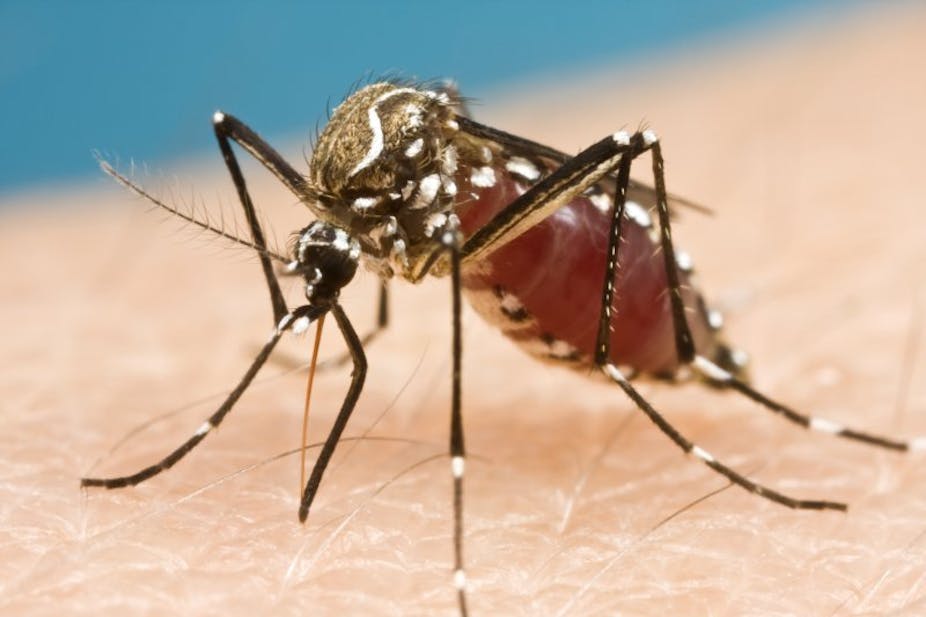Mosquito-borne diseases remain one of the greatest global threats to human health. Genetically modified (GM) mosquitoes hold great potential to reduce the burden of disease but as research moves from the laboratory into the field, concerns are emerging about how these new mosquito-control strategies are regulated.
History has taught us two things. Firstly, despite concerted efforts to eradicate mosquitoes and the disease-causing pathogens they transmit, there are still up to two million deaths due to malaria every year along with 100 million cases of dengue fever.
Second, some of the strategies we’ve employed in the past (such as draining wetlands, the widespread use of insecticides and the release of exotic fish for mosquito control) have had detrimental impacts on the environment. So how can we ensure that the next steps we take to reduce the burden of mosquito-borne disease will not have similar impacts to either human or environmental health?
Technological advances
New technologies enable new approaches to mosquito-borne disease management by targeting either the pathogen or the mosquito. An article published earlier today, for instance, describes how some researchers are using genetic modification of the malaria parasite to study the process of blood cell invasion and identify new parasite molecules, which may represent potential vaccine candidates. But the genetic modification of the mosquitoes themselves may also provide a way to combat mosquito-borne disease.
There have been many attempts to eradicate mosquitoes in the past through the use of insecticides and modification of the environment but mosquitoes are incredibly resilient. Perhaps the usefulness of genetic modification will not lie in the eradication or suppression of mosquito populations but rather in the reduction of mosquitoes’ capacity to transmit pathogens.

In the fight against dengue, for instance, the use of these new technologies is an exciting development. The ecology of dengue-transmitting mosquitoes, in particular the primary vector of dengue viruses Aedes aegypti, lends itself well to this type of control. The mosquitoes are closely associated with habitats around human dwellings (as opposed to natural wetlands) and occur at relatively lower population densities.
Mosquitoes such as Aedes aegpyti are less likely to play a significant ecological role compared with species associated with natural wetlands that may be an important food source for birds, bats, fish and other animals. But this doesn’t mean that the community or government regulators will be immediately supportive of GM mosquito release.
So while there’s no doubt that any new technology that assists the fight against malaria or dengue will be welcome, the question of how the environmental risks associated with GM mosquitoes will be assessed, on balance, with the potential benefits to human health remains unanswered. And given mosquitoes do not adhere to political boundaries, how will governments respond to the release of GM mosquitoes by their neighbours?
The need for regulation
New technologies may assist in overcoming the biological aspects of promising new control strategies but the hurdles associated with public acceptance may prove more difficult to overcome. So to ensure public acceptance, regulators will need to have a thorough and transparent process of risk assessment, considering all of the potential adverse environmental or human health impacts resulting from the release of GM mosquitoes. They also need to develop strategies that address both scientific and community concerns.
In an editorial of a special issue of PLoS Neglected Tropical Diseases looking at the potential use of genetically modified insects to control some of the most widespread vector-borne diseases, researchers discuss the problems GM insects pose for regulators and the importance of maintaining engagement with the community in the regulatory processes.

Discussing the releases of GM insects in the Cayman Islands, Malaysia and Brazil, one group proposes a set of scientific standards that may assist regulators. And although the workability of these proposals are debated in an expert commentary, the writers are in general agreement that the development of a standard checklist within the regulatory process would be beneficial.
The difficulty lies in developing a transparent process that effectively incorporates the widest range of potential concerns while including an opportunity for public comments. Another expert commentary explores the precedents for regulation of GM insects and proposes that the regulatory process may not be substantially different from the international guidelines currently in place for the mass release of non-GM insects, including non-native species, used for such purposes as crop pollination or pest control.
Staying dynamic
The difficulties with regulatory approval were highlighted in Australia recently with the release of Aedes aegypti containing the intracellular symbiotic bacterium Wolbachia. Mosquitoes “infected” with Wolbachia have been shown to have a reduced capacity to transmit dengue viruses and the first stage of field trials around Cairns, Far North Queensland, have shown promising results with regard to the establishment of Wolbachia infected populations of Aedes aegypti.
What’s interesting about the regulatory approvals for this field trial is that, as both Aedes aegypti and Wolbachia occur naturally in Australia and neither were genetically modified, the insects released were not considered a genetically modified organism (GMO) but a biological control agent. So rather than being regulated under the Gene Technology Act, they were actually classed as a veterinary chemical product and regulated by the Australian Pesticides and Veterinary Medicines Authority (APVMA).
There will always be new challenges for regulators, such as this one and it highlights the need for an adaptable framework that can respond to site-specific scientific, political and community concerns regarding the release of GM mosquitoes. Such mosquitoes will undoubtedly play a part in our fight against mosquito-borne disease but it’s important that the process of regulation can keep pace with technological developments.

